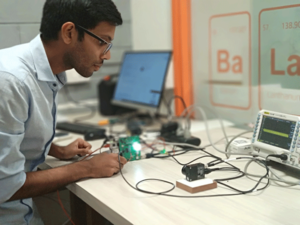
Name of Founder: Deepak Solanki
City: New Delhi
Revenues: Undisclosed
Headcount: 14
Industry: High-Tech
Investor Details & Amount Raise: Angle Investors from UK / Undisclosed Pre-Series AAt the age of 22, Deepak Solanki had it all figured out. An engineering student, Solanki toyed with robotics at IIT Bombay and IIIT Hyderabad and wanted to start something in the research space. The year was 2012 and Solanki registered a sole proprietorship business only to stumble across a technology called Light Fidelity (Li-Fi).
The internet today is powered by radio waves and Wi-Fi uses these waves to transmit data or power the Internet. Li-Fi as a technology was supposed to transmit data or power the Internet using light. Coined by Professor Harald Haas of the University of Edinburgh at a 2011 TED Global Talk, the system was to use LED bulbs to deliver networked, mobile, high-speed communication. What is remarkable is the fact Li-Fi can provide Internet speeds that are 100 times faster than convention
Recommended By Colombia
“When I stumbled across a technology called Li-Fi, I found it exciting. I started working on it along with a friend and got very good results,” says Deepak Solanki, Founder & CEO, Velmenni Research & Development (India).
By the summer of 2013 Solanki had a working prototype of this technology and was certain his revolutionary tech would find backers. “I was able to transmit data through light and initially thought I should go to a lighting company, since the technology involved LED bulbs. However, no one was interested and I decided to approach investors to raise funds and take my product from a prototype to a working model,” says Solanki, 27.
Solanki was, however, left disappointed again. No investor understood what Solanki was doing and his prototype was either brushed aside as a science experiment or something ahead of time. India was also going through an ecommerce boom and many investors suggested Solanki start something in the online space.
To sustain, Solanki picked up product consulting jobs for different companies in the electronics space till he got a chance in 2014 to join the Buildit hardware accelerator in Estonia. “The idea was to get into an accelerator, raise some seed money, improve on the product and come in contact with investors. We got a small seed round from Buildit and moved to Estonia,” says Solanki.
He joined the three month programme, met the tech community in Europe, pitched to multiple people and also managed to get a real time integration done for his product. “By 2015 we got a deal from an Estonian entrepreneur in the lighting domain to integrate Li-Fi in their LED lights. We created a system that proved that the product worked beyond the lab environment,” says Solanki.
By the summer of 2015, Solanki moved back to India because he wanted to set up his R&D team in the country. “Estonia was a small country and the number of engineering resources available was very less. That increased our cost and it only made sense to carry on with our work in India. By the end of 2015 and early 2016, we raised another round of funds from European investors and managed to get a couple of clients,” says Solanki